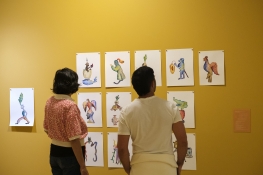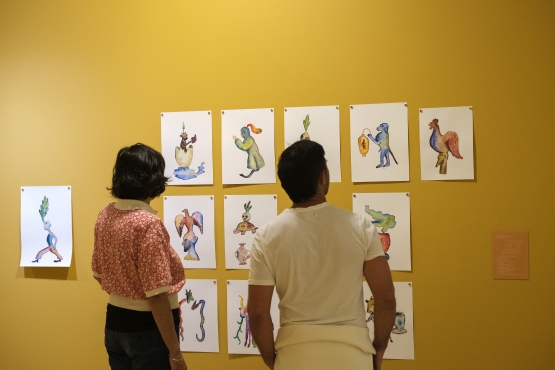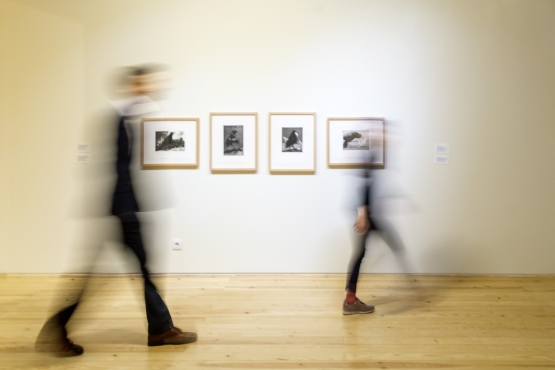The exhibition THE OTHER LIFE OF ANIMALS presents around seventy works by artists Ana Roque de Oliveira, António Manuel da Fonseca, Amadeo de Souza-Cardoso, António Soares, Dordio Gomes, Ema M, Henrique Pousão, Júlia Lema Barros, Júlio Pomar , Miguel Branco, Mikhail Karikis, Nelson Ferreira, Paula Rego, Pedro Proença, Rui Macedo, Sousa Pinto and TheLisbonWireman. Some works were created on purpose for this exhibition.
Curated by Emília Ferreira, Director of the National Museum of Contemporary Art, this exhibition presents works of drawing, painting, photography, sculpture, installation, video and media art.
The loss of biodiversity and consequent sustainability are central themes of our times, particularly for the new generations.
The curatorial proposal, under the theme "The Other Life of Animals" and aimed at children, is based on assumptions of the literary, artistic and philosophical tradition about animals and the way in which our relationship with them has been defined, shaped and experienced and how it has changed, especially in recent times, and our responsibility for their, and our, survival has also changed.
A catalog will be available, with two editions, one in Portuguese and one in English. Through Zoomguide – an online APP – it will also be possible to collect information about some of the artists and works on display.
Open until 28 August, this exhibition
is sponsored by the Millennium bcp Foundation, and supported by Lusitânia
Seguros, Hotéis Heritage and TintasCIN.
EXHIBITION CONTEXT
“Our species is a storyteller.
And, since the dawn of time, she recorded and recreated, along with her presence, the history of the animals that accompanied her. Over the centuries, animals have been seen by us in many ways. In Egypt, some were considered gods.
In other cultures, they were considered important attributes of the gods. But, in general, they were seen as very different from us. As if our species were really superior to all the others and could dispose of the others at will.
We invented characteristics and powers for them that, in some cases, are the result of our powerful imagination. But our imagination has conditioned our way of seeing. For a long time, our view of other species dictated what we considered important to study or know about them. We saw them as things we could own.
Deprived of a nature equal to ours, animals had no rights.
In the first globalization, from the 15th century onwards, when European navigators and explorers, especially Spanish and Portuguese, arrived in other parts of the globe, they were confronted not only with ways of life and human thought different from their own, but also with species botanists and animals they had never seen.
On the way back from many of these trips, reports, drawings, and even plants and animals arrived in Europe (and, in some cases, even people who, due to their different habits and thoughts and different appearance from ours, were seen as animals too). These botanical and animal specimens formed part of collections – which were called Cabinets of Curiosities – and contributed to further nourishing the knowledge and imagination of writers, artists, scientists and more thinkers.
In the 19th century, the British scientist, Charles Darwin (1809-1882), proposed a different way of thinking about our place in the world, integrating us into the same general history, in an evolutionary line. More than a hundred years later, and after many species extinctions caused by our own, we have finally begun to realize that what we do to others also has serious consequences for us.
Their lives, which we have kept secret and enclosed in images created by us, are, after all, much richer than we imagine. We finally realize that each species we drive to extinction doesn't just mean the loss of beauty or diversity — which would be serious enough — but that it puts us, too, closer to our own end.
Will we continue to keep the voices of other animals secret, leading them to the last and insurmountable secret - that of their disappearance forever - or will we be able to give voice to others and, with that, better understand our own voice?
Will we continue to deny our animal nature?
These are some of the many questions that we intend to leave in your hands, with this exhibition, in which we will show you how some artists of today, taking the past, ask questions and tell stories that lead us to understand some of the many secret lives of animals. Because if much of the life of animals has been, over the centuries, imagined by us, the biggest secret is what we have yet to discover. Together with them.”, explain Ana Vasconcelos and Emília Ferreira.
Man's artistic relationship with animals has been a constant since the beginning of human history, as we know it. Prehistoric art, cave paintings and engravings, to which many scholars attribute functions and characteristics comparable to those of current art, is an example of the beginning of this interconnection and our inspiration in the animal world.
“The Other Life of Animals” is the new exhibition that we are pleased to present at the Millennium bcp Gallery, at the National Museum of Contemporary Art, curated by Emília Ferreira in collaboration with Ana Vasconcelos, Casa das Histórias Paula Rego and the Museum of Natural History and Science and of several contemporary artists. This exhibition of real and fantastic animals features works of drawing, painting, photography, ceramics, sculpture, and media art, having been designed for a younger audience, but where all ages are welcome.
"I invite all visitors to get involved in this artistic look at the bonds that have always linked us to animals, so that we do not forget that, in the fragile balance of Nature, we are also an animal species”, says António Monteiro, President of the Millennium bcp Foundation.













